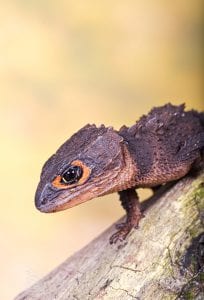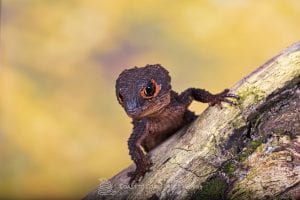 Red Eyed Crocodile skinks are an amazing species that occurs in Papua New Guinea, Admiralty Islands. They have become a very popular species since being imported into the country since the mid-1990’s. Their mini-dragon appearance and their bright red “eye-liner” are no doubt very appealing – add to this their slow movement making them a “tame” species too.
Red Eyed Crocodile skinks are an amazing species that occurs in Papua New Guinea, Admiralty Islands. They have become a very popular species since being imported into the country since the mid-1990’s. Their mini-dragon appearance and their bright red “eye-liner” are no doubt very appealing – add to this their slow movement making them a “tame” species too.
We have bred this species at Coast to Coast Exotics, it is a very easy species to keep and breed. In the wild they have lived on forest floors, in leaf litter and other debris, for tens of thousands of years. Unfortunately this is changing. As coconut plantations have spread into the Red Eyed Crocodile Skinks natural habitat, they are remarkably adaptable and are surviving now under the coconut husks. This explains why they do so well in captivity.
A glass vivarium is advisable to cope with the high humidity levels and dampness this species requires. Aim for a vivarium of around a 1m length. A deep layer of substrate allows for natural  burrowing activity – I prefer a mix of orchid bark, leaf litter and coir and keep it quite damp. Hiding places still need to be provided, cork bark is ideal, pack some of the hides with sphagnum moss to give areas of higher humidity. Climbing branches should be provided, although they are only opportunist climbers. A low water bowl ideally sunk into the substrate is ideal for bathing and drinking.
burrowing activity – I prefer a mix of orchid bark, leaf litter and coir and keep it quite damp. Hiding places still need to be provided, cork bark is ideal, pack some of the hides with sphagnum moss to give areas of higher humidity. Climbing branches should be provided, although they are only opportunist climbers. A low water bowl ideally sunk into the substrate is ideal for bathing and drinking.
Vivarium heating is required, room temperature is a little low. In the wild a night time temperature would rarely go lower than around 22C, with a day time temperature in the shady cool forest floor of around 27-28C. This can be provided with an overhead heater such as an incandescent or ceramic bulb, my preference is a ceramic heater as it gives off no light – it can be used for day and night. Lighting is best provided by one of the lower level T5 fluorescent tubes,  one of my favourites is the Arcadia ShadeDweller tubes.
one of my favourites is the Arcadia ShadeDweller tubes.
Day to day maintenance would be feeding, spraying the vivarium with tepid water and checking temperatures. They eat a wide range of commercially available livefood; crickets, small locusts, waxworms, earthworms and cockroaches. Supplement their diet with a good quality reptile balanced multivitamin and mineral supplement.

do these crocodile skinks need uv